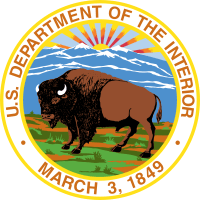William Freeman Vilas
| The Honorable William Freeman Vilas | |
|---|---|
 | |
| United States Senator from Wisconsin | |
|
In office March 4, 1891 – March 3, 1897 | |
| Preceded by | John Coit Spooner |
| Succeeded by | John Coit Spooner |
| 33rd United States Postmaster General | |
|
In office March 6, 1885 – January 6, 1888 | |
| President | Grover Cleveland |
| Preceded by | Frank Hatton |
| Succeeded by | Donald M. Dickinson |
| 17th United States Secretary of the Interior | |
|
In office January 16, 1888 – March 6, 1889 | |
| President | Grover Cleveland |
| Preceded by | Lucius Q.C. Lamar |
| Succeeded by | John Willock Noble |
| Personal details | |
| Born |
July 9, 1840 Chelsea, Vermont, U.S. |
| Died |
August 27, 1908 (aged 68) Madison, Wisconsin, U.S. |
| Political party | Democratic |
| Spouse(s) | Anna M. Vilas |
| Alma mater |
University of Wisconsin–Madison University at Albany |
| Profession | Politician, Lawyer |
| Military service | |
| Allegiance |
Union |
| Service/branch |
Union Army |
| Rank |
|
| Unit |
|
| Battles/wars | American Civil War |
William Freeman Vilas (July 9, 1840 – August 27, 1908) was a member of the Democratic Party who served in the United States Senate for the state of Wisconsin from 1891 to 1897.[1] He was a prominent Bourbon Democrat.
Life and career
Vilas was born in Chelsea, Vermont, the son of Esther Greene (Smilie) and Levi Baker Vilas, a politician. Vilas moved to Madison, Wisconsin with his family in 1851. He graduated from the University of Wisconsin–Madison in 1858, and from the Albany Law School in 1860. He enlisted in the Union Army during the Civil War and was a captain in the 23rd Wisconsin Volunteer Infantry Regiment and later served as the lieutenant colonel of that regiment.
Following the war, Vilas was a Professor of Law at the University of Wisconsin–Madison, and a regent of the University from 1880 to 1885 and 1898 to 1905. Vilas served as a member of the Wisconsin State Assembly in 1885, until he was appointed the Postmaster General between 1885 and 1888, and as Secretary of the Interior from 1888 to 1889, both under President Grover Cleveland.
After leaving the cabinet, he led Wisconsin German Americans in the protest against the Bennett Law of 1889 which required schools to only use the English language. From 1891 until 1897 he was a member of the United States Senate, in which, during President Cleveland's second term, he was recognized as the chief defender of the Administration, and he was especially active in securing the repeal of the silver purchase clause of the Sherman Silver Purchase Act. He was unsuccessful in an 1896 reelection bid, having been defeated by Senator John Coit Spooner.
Vilas was a delegate to the Democratic National Convention of 1896, but withdrew after the adoption of the free-silver plank. He then became one of the chief organizers of the National Democratic Party, attended the convention at Indianapolis, and was chairman of its committee on resolutions. He was also the main drafter of the National Democratic Party's platform. Vilas, a favorite of the delegates, refused to run as the party's sacrificial lamb.
He is interred at the Forest Hill Cemetery in Madison, Wisconsin.
Vilas County, Wisconsin is named for William F. Vilas.[2] Senator Vilas is also the namesake of the town of Vilas, South Dakota.[3]
See also
References
- ↑ Vilas, William Freeman 1840 - 1908 at www.wisconsinhistory.org
- ↑ Vilas County History
- ↑ Chicago and North Western Railway Company (1908). A History of the Origin of the Place Names Connected with the Chicago & North Western and Chicago, St. Paul, Minneapolis & Omaha Railways. p. 134.
Sources
| Wikimedia Commons has media related to William Freeman Vilas. |
- William Freeman Vilas at the Biographical Directory of the United States Congress Retrieved on 2008-02-15
External links
| Political offices | ||
|---|---|---|
| Preceded by Frank Hatton |
United States Postmaster General Served under: Grover Cleveland 1885–1888 |
Succeeded by Donald M. Dickinson |
| Preceded by Lucius Q.C. Lamar |
U.S. Secretary of the Interior Served under: Grover Cleveland 1888–1889 |
Succeeded by John W. Noble |
| United States Senate | ||
| Preceded by John C. Spooner |
Senator from Wisconsin (Class 3) 1891–1897 with Philetus Sawyer (1891–1893) John L. Mitchell (1893–1897) |
Succeeded by John C. Spooner |
| ||||||||
| ||||||||||||
| |||||||||||||||||||||||||||||||||||
|


